The ELF Gains Traction
Air Date: Week of April 24, 2015
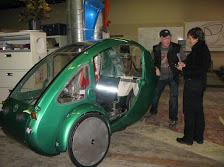
Inventor Rob Cotter shows reporter Helen Palmer the ELF. (Photo: Joanna Rifkin)
ELF stands for Electric, Light and Fun, And this particular Elf is an invention that launched with a kickstarter in 2013. As Living on Earth’s Helen Palmer reported, it's a human and solar powered covered tricycle that aims to create a commuting revolution, and might just help combat climate change. Now two years on from the Elf’s kickstarter campaign, its designer and developer, Rob Cotter, tells Living on Earth's Helen Palmer how successful the invention has proved, and how much of a contribution it’s making to cutting CO2 emissions.
Transcript
CURWOOD: It’s Living on Earth. I’m Steve Curwood. In April, when we celebrate the Earth, and Earth Day, we try to update some intriguing stories we’ve run. Today we’re revisiting the ELF, a human and sun-powered enclosed bicycle that a company in North Carolina launched with a Kickstarter campaign in 2013. Here’s part of our report from Living on Earth's Helen Palmer.
[TRAFFIC SOUNDS]
PALMER: Organic Transit - that makes of the Elf - occupies an old furniture warehouse in downtown Durham, North Carolina. In the huge showroom window is what looks like a large green egg-shaped motorcycle sidecar on top of a racing wheelchair. Now, a sun-powered tricycle sounds like the brainchild of a young alternative engineer, but its inventor hardly fits that mold.
COTTER: Hi Helen, I'm Rob Cotter with Organic Transit.
PALMER: Rob Cotter is in his 50s, a slightly rumpled and unassuming-looking engineer with plenty of hands-on experience.
COTTER: Many years ago I was working for Porsche and BMW more on the race-car side of things - and I was living in Southern Calif.- and they were building the Gossamer Condor and Gossamer Albatross - the pedal-powered aircraft - not too far from me, so I kind of linked up with those folks.
PALMER: That led to a host of new possibilities - Cotter's a working inventor who's learned many skills along the way.
COTTER: I became vice president of land for human-powered vehicles, I built a 62mph tricycle about 30 years ago - and once I realized you could go highway speeds at one horsepower - I realized how inefficient everything is that we do.
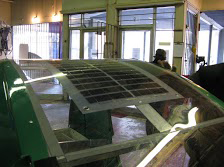
Solar Panels on top of the ELF. (Photo: Joanna Rifkin)
PALMER: That realization and all that experience went into making this new alternative vehicle, the Elf – not something from Lord of the Rings – but an acronym.
COTTER: It's actually Electric, Light and Fun.
PALMER: Light and fun, but not tiny.
COTTER: It's under 4 feet wide, 8 feet long and a little under 5 feet tall.
PALMER: At that height, he says, you sit in traffic at eye level with cars. The open sides and huge front windshield mean you can see, and the electric headlights and indicators mean you can be seen; you're protected by a sturdy aluminum frame that anchors the body panels front and back. There's space behind the driver to put a child seat and it can carry up to 350 pounds of cargo, but the Elf is still a bicycle.
COTTER: It has pedals and a chain and drives a rear wheel, but there's also solar panels and an electric motor to help get it down the road.
PALMER: Rob says the Elf gives people the choice of how much exercise to take - you can use the electric motor to help get up the hills on the way to work - so you don't arrive too sweaty - then let it sit in the sun for the solar panels to charge the battery. And it's not only the Elf's color and its power source that are green.

Steering handles and pedals on the ELF. (Photo: Joanna Rifkin)
COTTER: A lot of materials that go into this are recycled materials - the aluminum's 45 percent recycled, it's just a very efficient package - so efficient that it gets an equivalent of 1800 mpg.
PALMER: But of course, it uses no gas at all: just human-power, sun-power and a battery pack with a 30-mile range. It's not built for highways though - only for local roads, and bike trails, as federal regs say a bicycle can't go faster than 20 miles an hour. Cotter says if enough people who drive about 30 miles a day climbed out of their cars and into an Elf - the effect on greenhouse gas emissions could be startling.
COTTER: Each one of these on the road takes about 28 tons of CO2 out of the atmosphere per year.
PALMER: Compared with an equivalent car?
COTTER: That's right, it mitigates the 28 tons - so 100 of these on the road are equivalent to a 4-megawatt wind turbine at about 20% of cost.
PALMER: Ah cost! That's always one of the big questions about any new technology.
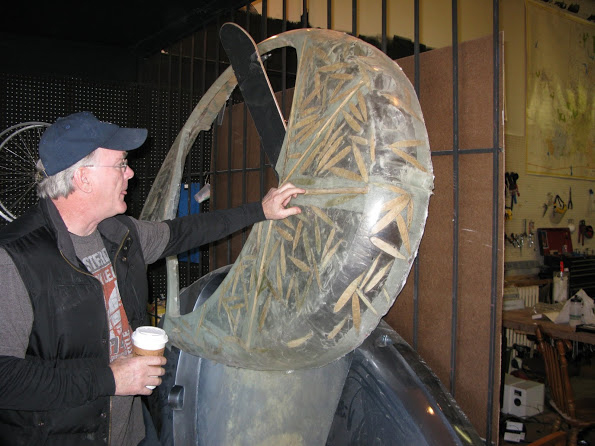
Rob Cotter with ELF side panel; note embedded bamboo leaves. (Photo: Joanna Rifkin)
COTTER: The base price is $4000 - and basically that's like the wholesale price - but we have over 400 orders or reservations currently, just from our website.
PALMER: And that was before the Kickstarter campaign got underway - they reached their $100,000 funding goal in 12 days and 40 people have actually paid for the vehicles.
By now I really wanted a personal test-drive in this powered trike – though I was a little apprehensive.
COTTER: We call the green one the green onion.
PALMER: How safe do you think they are if somebody runs into them?
COTTER: Safer than a bicycle – so this is like riding inside a bike helmet. So let me pop this door open here…
PALMER: But with hands full of recorder and microphone - I wasn't sure if I could actually ride or steer the thing - indeed - I couldn't even work out how to climb into it.
COTTER: So what I do - it's kind of like getting into a kayak - so I take a big step - keep your feet on the pedals - it's much the safest to keep your feet on the pedals.
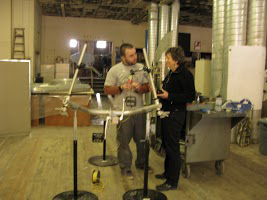
Mechanic Brian Highfill with reporter Helen Palmer. (Photo: Joanna Rifkin)
PALMER: So, feet on the pedals - and microphone stuffed inside my jacket - I was ready:
COTTER: So make a left at the light - up to the bull - see that bull statue? Make a right after that.
PALMER: And I set off pedaling unsteadily into the traffic.
[TRAFFIC SOUNDS]
PALMER: Wow – I’ve come to a red light so I’m stopping - she's letting me go. That’s amazing. I'm turning in front of the traffic. Oh, wow! This is very wonderful. OK, it’s quite a bit of actual pedaling so it’s not easy - but I could of course put on electric motor so let’s try that. Oh, yes, oh my goodness, I just put the motor on and it’s great! OK, there’s nothing coming so I can turn round here Oh it’s easy! You get the hang of it in like three minutes. I'm being followed by a fire engine.
Well, except for the fire-truck, it was fun, but more challenging than I'd expected and given the turn signals and the traffic, there was a lot to remember. But it's certainly easier than learning to ride a bike - and the electric power on the hills was great.
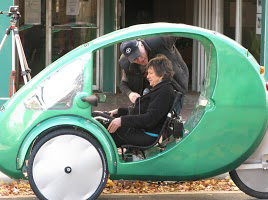
Instruction from Rob Cotter (Photo: Joanna Rifkin)
So don't be surprised to see a solar-pedal-powered trike heading down a bike-path near you soon. For Living on Earth, I'm Helen Palmer in Durham, North Carolina.
[TRAFFIC SOUNDS]
CURWOOD: Helen joins us now in the studio. So that was back in January 2013. What’s happened since?
PALMER: Well, as you remember they were just at the end of their Kickstarter campaign, so I called up Rob Cotter, the CEO of the company and here’s what he told me.
COTTER: Since then we’ve sold about 500 units, we’ve delivered them to eight countries, we’re looking at manufacturing in four other countries presently and we’ve prevented from entering the atmosphere somewhere around 200,000 tons of CO2.
PALMER: Well, I know one of the plans you had was to manufacture in other urban centers around the US. Have you managed to get that off the ground?
COTTER: We've done some of that. We actually worked with an organization in San Jose that trains homeless people to become bicycle mechanics, so we went there as kind of a test pilot to see who could build this and how, and in a week's time we taught them how actually to build ELFs, and maintain them, and service them, and all the tooling it takes to do that, and now we are in talks with organizations in Holland, in Belgium, New Zealand and Fiji, to be building them there as well in other parts of the US.
PALMER: So this is obviously something that's caught a wave in other countries as well. What response have you had from other countries about the Elf?
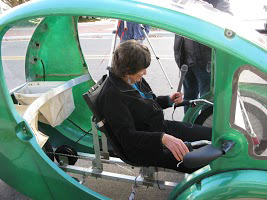
"Where can I put the microphone?"
Helen Palmer prepares to test-drive the ELF.
(Photo: Joanna Rifkin)
COTTER: So, I think one thing we have to be realistic about is that pretty much every country is a better market than the US. Even though there's a renaissance taking place here with bicycles in the US and the mindset of people wanting to live in urban areas and have a smaller footprint so to speak, we don't really have the infrastructure of most other countries, and we don't have the mindset of drivers that allow bicycles to have a bigger portion of the road. So, the response we've gotten from other countries oftentimes is "This can't be made in the US. This must be made in Germany."
PALMER: What is it that we're missing that other countries are getting, both in terms of infrastructure and attitude?
COTTER: So, over the past 75 years or so, we've become a very auto-centric culture. We don't have a lot of bike paths, we don't have a lot of separated bike paths, we don't have a lot of wide shoulders for bicycles to safely travel on the same routes as automobiles, and then a lot of the drivers are not familiar with cyclists on the road. And as we have more and more cyclists coming on to the roads, many of those are actually not skilled and understand how to ride safety as well. So two of the things that the Elf does is provide weather protection and increases the safety immensely over a conventional bicycle, with the composite shell for safety, with the visibility of the higher profile body and then with the turn signals and brake lights and all those things.
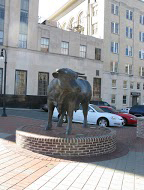
Durham's mascot - the Bull. (Photo: Joanna Rifkin)
PALMER: Now, I know you've had some new developments in terms of the actual, what the Elf looks like, what capacity the Elf has. Tell me what developments you've made since I saw it two-and-a-half years ago.
COTTER: So, in the past 18 months or so, we've made about 110 changes on the basic Elf. Some little tiny details of like different washers and little aluminum tabs to significant changes like we made a two-seater called the two-fer. So, there's all sorts of changes that are happening throughout, in fact, perhaps, since you were involved so early on ...we had a 65 watt panel back then, and now it comes standard with a 100 watt panel and somewhere in the future it will be significantly higher once again.
PALMER: So, tell me what kinds of uses people are putting their Elves to. What are they doing with it that has particularly surprised or interested you?
COTTER: Well, it's really amazing. People are using them all winter long in places like Canada. They're pulling trailers, 500, 600 pound trailers around with snow-blowing equipment and yard equipment on there. They turn them into food trucks. There's a gentleman in Pasadena that has a gelato freezer on the back...it's kind of a solar-operated freezer he sells his gelato out of. One gentleman rode from Ontario, Canada, to Key West, Florida, on his Elf all on secondary roads and bike paths. But the thing that amazes me most I think is people with disabilities that are using the Elf to increase their mobility. So, this one woman, she broke both her legs in 20 places and doctors said she would never walk again without assistance. And she purchased an Elf, she lowers herself in it, and takes off on electric power, and when she can she goes ahead and just rotates the pedals. And six months later, she's riding 22 miles a day and able to walk without a cane.
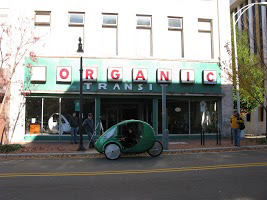
The Elf outside Organic Transit's showroom (Photo: Joanna Rifkin)
PALMER: This must be very pleasing to you as the father of the Elf.
COTTER: Oh, it is. Yes, and it's just always continually amazed with what people are doing with them. Absolutely.
PALMER: So, what do you think the future is?
COTTER: So for us, if we're not incredibly successful, we're not having the impact on climate change that we would like to have. So our goal is to have tens of thousands of units, and also different models - the truck model, the van model, or even just a much more ecological golf cart. And then ultimately somewhere down the road we'd build a fully enclosed three-wheeled motorcycle that would do highway speeds and have a range of 250 miles. And all these are filling that space between a bicycle and a car that are zero pollution, that are very economical to maintain and run and are supplemented in large part by solar.
PALMER: So, Steve, Rob Cotter’s got big plans – and he’s made great improvement on the basic Elf – but as a result the price has gone up from $4,000 to more than $5,000!
CURWOOD: Well, that’s business isn't it? Living on Earth’s Helen Palmer. Thanks so much.
Links
Living on Earth wants to hear from you!
Living on Earth
62 Calef Highway, Suite 212
Lee, NH 03861
Telephone: 617-287-4121
E-mail: comments@loe.org
Newsletter [Click here]
Donate to Living on Earth!
Living on Earth is an independent media program and relies entirely on contributions from listeners and institutions supporting public service. Please donate now to preserve an independent environmental voice.
NewsletterLiving on Earth offers a weekly delivery of the show's rundown to your mailbox. Sign up for our newsletter today!
 Sailors For The Sea: Be the change you want to sea.
Sailors For The Sea: Be the change you want to sea.
 The Grantham Foundation for the Protection of the Environment: Committed to protecting and improving the health of the global environment.
The Grantham Foundation for the Protection of the Environment: Committed to protecting and improving the health of the global environment.
 Contribute to Living on Earth and receive, as our gift to you, an archival print of one of Mark Seth Lender's extraordinary wildlife photographs. Follow the link to see Mark's current collection of photographs.
Contribute to Living on Earth and receive, as our gift to you, an archival print of one of Mark Seth Lender's extraordinary wildlife photographs. Follow the link to see Mark's current collection of photographs.
 Buy a signed copy of Mark Seth Lender's book Smeagull the Seagull & support Living on Earth
Buy a signed copy of Mark Seth Lender's book Smeagull the Seagull & support Living on Earth

